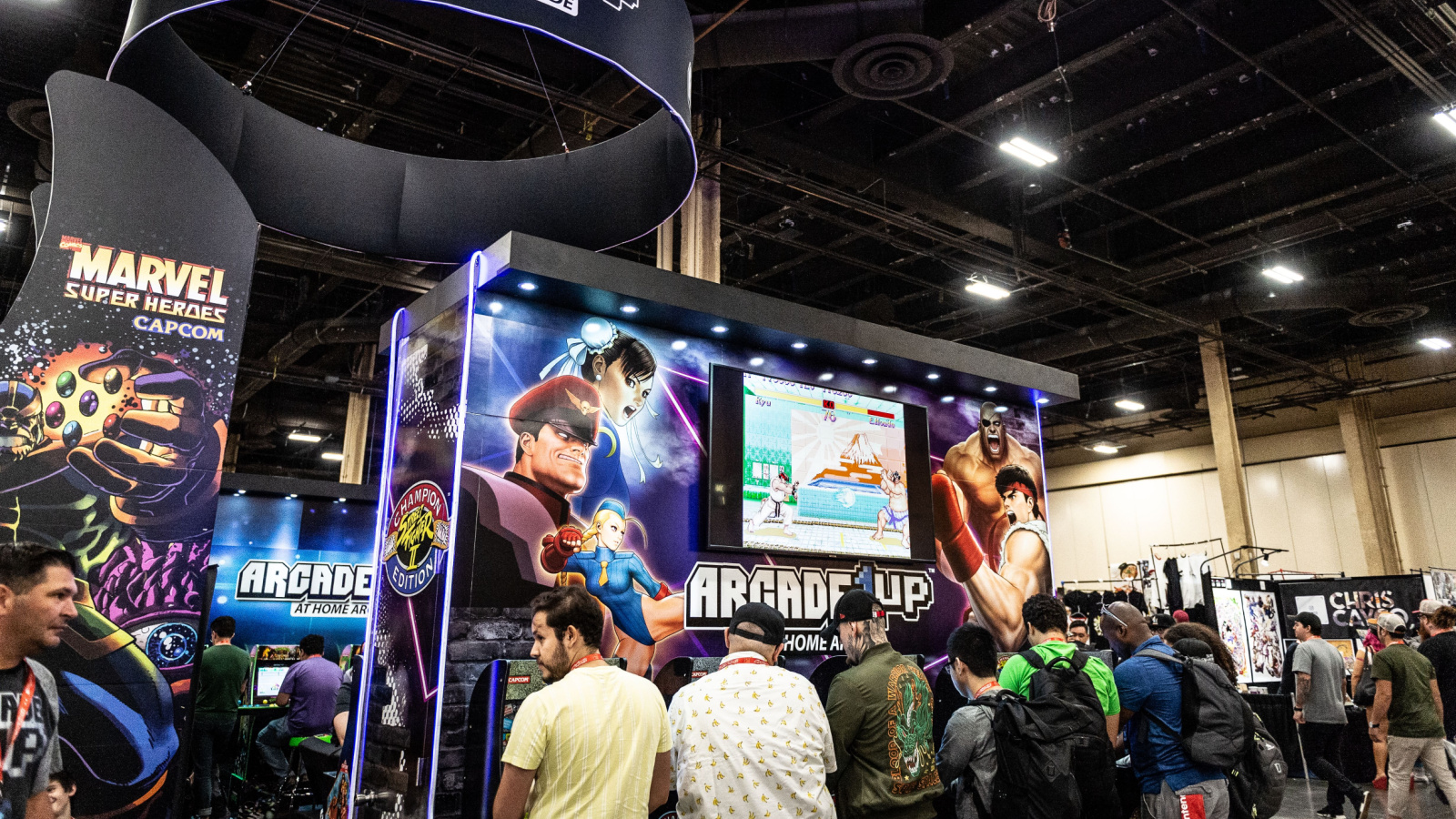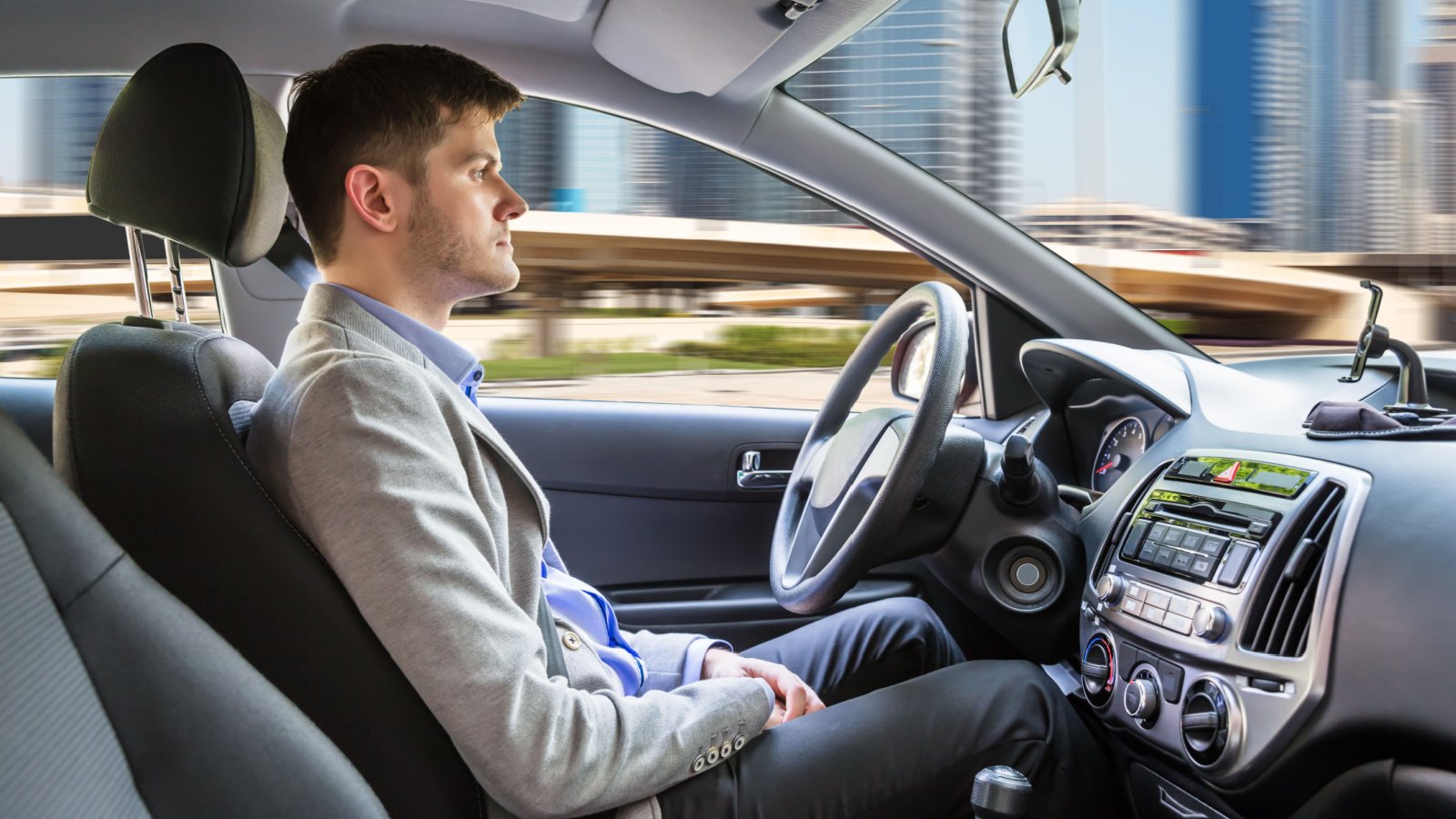Revisit the charms and oddities of daily life in the ‘90s when life was simpler, and no one had a smartphone. Everything was different – from how we worked and played to how we connected with friends and interacted with media. Let’s remember what life was like before Y2K, 9/11, and iPods.
Home Video Rental Stores

In the ‘90s, a trip to the local video rental store was a regular weekend activity. Families and friends would browse aisles of VHS tapes, debating over new releases and hidden gems. The excitement of holding a physical copy of a movie for a night felt like a special occasion.
Portable CD Players

The portable CD player was the ultimate accessory for music lovers on the go. Clipping one onto your belt and threading headphones through your jacket gave a soundtrack to your day. This personal music experience laid the groundwork for the digital music revolution.
Landline Phones

The family landline phone was the central hub of communication. Waiting for a call meant physically being near the phone, often leading to long chats sprawled on the living room floor. The distinct ring, the tangled cords, and the shared family phone line were all part of the ritual.
Dial-Up Internet

The unmistakable sound of dialing up the internet is etched in the memories of ‘90s kids. The anticipation built with each beep and crackle, leading to the digital world at your fingertips. Though slow and noisy, it was our first gateway to the internet.
Encyclopedias

Before the internet became our primary source of information, encyclopedias were the go-to. A full set was a prized possession, displayed prominently on bookshelves. Flipping through the pages to research for a school project was a learning experience.
Disposable Cameras

The disposable camera was the perfect companion for capturing spontaneous moments. The excitement of not knowing how the photos turned out until developed added a layer of mystery. This anticipation is a lost art in the age of digital photography.
Fax Machines

In the ‘90s, the fax machine was a symbol of business efficiency. Sending a document across the world in minutes was a marvel of technology. The whir of the machine and the warm scent of printed fax paper were synonymous with productivity. This once-essential office tool is now a relic of the past.
Cassette Tapes

Creating a mixtape on a cassette was a labor of love. Carefully selecting each song, pressing record at just the right moment, and handwriting the track list made each tape unique. This personal touch added value to the music and the act of sharing it.
Physical Maps

Navigating with a physical map was an adventure in itself. Unfolding a large paper map and plotting a route made every trip feel like an exploration. The creases and notes added to the map told stories of past journeys. This hands-on navigation is a lost skill in the GPS era.
Phone Booths

Phone booths were not just for making calls; they were beacons for those in need of communication. Dropping coins into the slot, dialing a number, and speaking into the receiver was an experience unique to the era.
Answering Machines

The answering machine was the gatekeeper of communication. Coming home to the blinking light indicating a new message brought a sense of anticipation. Listening to each message, whether mundane or exciting, was a daily ritual.
Film Photography

The art of film photography required patience and skill. Loading film, adjusting settings, and waiting to see the developed photos was a slow yet rewarding process. The digital age has sped up this process, but the magic of film remains unmatched.
Walkie-Talkies

Before instant messaging, walkie-talkies were the epitome of cool communication. The thrill of talking to someone in another room or down the street felt like a secret mission. These devices fostered a sense of adventure and camaraderie among friends.
Pagers

Carrying a pager was a status symbol and a lifeline for quick communication. Receiving a page meant finding the nearest phone to return the call, adding a layer of intrigue to each message. The transition to mobile phones marked the end of this unique era.
Arcade Games

Arcades were the social hubs for gaming enthusiasts. The sound of tokens clinking, buttons being mashed, and the glow of screens created an electrifying atmosphere. Competing for high scores and bonding over favorite games was a communal experience.
VCRs

The VCR was a household staple, allowing us to record and rewatch our favorite TV shows and movies. Planning your evening around a TV schedule and then being able to fast-forward through commercials was a luxury.
Print Newspapers and Magazines

The morning routine often included flipping through a print newspaper or magazine. The smell of the ink, the rustle of the pages, and the ritual of reading over breakfast was grounding. Digital media has transformed this experience, making it more accessible.
Public Libraries as a Research Hub

Spending hours among the library stacks, finding the right books, and taking notes was a common academic practice. The library’s quiet and studious atmosphere provided a unique sense of community and scholarship.
Handwritten Letters

The art of writing and receiving handwritten letters was a personal and intimate form of communication. Each letter was a tangible piece of the sender, imbued with their time and thought. Email and instant messaging have replaced this slow, deliberate form of connection.
Physical Board Games and Card Games

Game nights were a staple of social interaction, with physical board games and card games at the center. These games fostered face-to-face interaction, strategy, and laughter. While online gaming is popular, the charm of gathering around a game remains unbeatable.
Scheduled TV Programming

The concept of scheduling your day around your favorite TV show seems archaic now. The anticipation of a weekly episode brought people together, sparking conversations and theories. Streaming on demand has changed our viewing habits.








https://semaglupharm.com/# rybelsus drugs.com
Semaglu Pharm: Semaglutide tablets without prescription – SemagluPharm
prednisone daily buy prednisone online no prescription PredniPharm
http://semaglupharm.com/# Semaglu Pharm
LipiPharm: Lipi Pharm – LipiPharm
Semaglu Pharm: SemagluPharm – can you get rybelsus over the counter
https://semaglupharm.com/# how long after taking rybelsus can i eat
Lipi Pharm another name for lipitor Affordable Lipitor alternatives USA
Over-the-counter Crestor USA: Crestor mail order USA – CrestorPharm
https://semaglupharm.com/# п»їBuy Rybelsus online USA
prednisone brand name in usa: PredniPharm – Predni Pharm
https://semaglupharm.shop/# SemagluPharm
Affordable cholesterol-lowering pills CrestorPharm crestor intensity
prednisone pill 10 mg: prednisone 10mg – PredniPharm
https://semaglupharm.com/# Rybelsus online pharmacy reviews
SemagluPharm: SemagluPharm – Order Rybelsus discreetly
SemagluPharm: Semaglu Pharm – direct meds semaglutide
http://prednipharm.com/# prednisone 1mg purchase
https://semaglupharm.shop/# how long can you take rybelsus
CrestorPharm: Crestor Pharm – Crestor Pharm
india buy prednisone online Predni Pharm prednisone 1mg purchase
LipiPharm: what tier is atorvastatin 20 mg – Lipi Pharm
https://semaglupharm.com/# Semaglu Pharm
rosuvastatin calcium tablets market: No doctor visit required statins – CrestorPharm
rosuvastatin 20 mg picture CrestorPharm п»їBuy Crestor without prescription
SemagluPharm: rybelsus drugs.com – Semaglutide tablets without prescription
http://semaglupharm.com/# what is the difference between ozempic and semaglutide
https://crestorpharm.com/# side effects of crestor cholesterol medication
LipiPharm: lipitor 40mg – Lipi Pharm
Generic Crestor for high cholesterol CrestorPharm Crestor Pharm
rybelsus drug: Affordable Rybelsus price – SemagluPharm
https://semaglupharm.com/# Semaglu Pharm
LipiPharm: LipiPharm – is atorvastatin a statin
Semaglu Pharm SemagluPharm rybelsus hair loss
Affordable Rybelsus price: why am i so tired on semaglutide – Affordable Rybelsus price
https://semaglupharm.com/# semaglutide vs wegovy
https://prednipharm.com/# generic prednisone for sale
Buy cholesterol medicine online cheap: are there any dietary restrictions while taking crestor – Crestor Pharm
Crestor 10mg / 20mg / 40mg online CrestorPharm CrestorPharm
Semaglu Pharm: Semaglu Pharm – SemagluPharm
http://semaglupharm.com/# what happens if you take rybelsus with food
prednisone buy without prescription: PredniPharm – prednisone 60 mg tablet
http://semaglupharm.com/# SemagluPharm
prednisone for sale no prescription: prednisone tablets – Predni Pharm
http://semaglupharm.com/# semaglutide oral vs injection
prednisone 50 mg canada: Predni Pharm – can you buy prednisone online uk
CrestorPharm CrestorPharm cholesterol medicine rosuvastatin side effects
Semaglu Pharm: Affordable Rybelsus price – SemagluPharm
https://crestorpharm.shop/# Crestor 10mg / 20mg / 40mg online
https://semaglupharm.com/# still hungry on semaglutide
SemagluPharm: SemagluPharm – semaglutide injection sites
SemagluPharm Affordable Rybelsus price rybelsus drug class
Crestor Pharm: CrestorPharm – Buy cholesterol medicine online cheap
https://indiapharmglobal.com/# India Pharm Global
vipps canadian pharmacy: Canada Pharm Global – canada rx pharmacy
canadapharmacyonline com canadianpharmacymeds com canadian pharmacy in canada
canadian drug pharmacy: Canada Pharm Global – pharmacy in canada
http://indiapharmglobal.com/# India Pharm Global
http://canadapharmglobal.com/# best canadian pharmacy online
canadadrugpharmacy com: ed meds online canada – canadian pharmacy meds review
mexico pharmacies prescription drugs: Meds From Mexico – Meds From Mexico
buying prescription drugs in mexico online mexican rx online Meds From Mexico
https://medsfrommexico.com/# Meds From Mexico
https://canadapharmglobal.com/# canadian pharmacy ltd
safe canadian pharmacy: medication canadian pharmacy – canadian pharmacy sarasota
indian pharmacy paypal: indian pharmacy online – buy prescription drugs from india
India Pharm Global India Pharm Global India Pharm Global
https://medsfrommexico.com/# mexican pharmaceuticals online
top online pharmacy india: top online pharmacy india – India Pharm Global
Meds From Mexico: Meds From Mexico – medicine in mexico pharmacies
Meds From Mexico Meds From Mexico Meds From Mexico
http://medsfrommexico.com/# Meds From Mexico
https://medsfrommexico.shop/# purple pharmacy mexico price list
buy prescription drugs from india: india pharmacy – indian pharmacy online
mexican border pharmacies shipping to usa: medication from mexico pharmacy – mexican rx online
mexico drug stores pharmacies Meds From Mexico Meds From Mexico
https://indiapharmglobal.com/# India Pharm Global
India Pharm Global: indian pharmacy online – India Pharm Global
Meds From Mexico medicine in mexico pharmacies Meds From Mexico
indian pharmacy: India Pharm Global – India Pharm Global
legitimate canadian pharmacy: Canada Pharm Global – pet meds without vet prescription canada
https://medsfrommexico.com/# Meds From Mexico
https://canadapharmglobal.com/# pet meds without vet prescription canada
reputable mexican pharmacies online Meds From Mexico Meds From Mexico
canadian pharmacy world: Canada Pharm Global – canadapharmacyonline
best canadian online pharmacy: Canada Pharm Global – canadianpharmacy com
https://canadapharmglobal.shop/# canadian pharmacy com
mexican border pharmacies shipping to usa mexico pharmacies prescription drugs п»їbest mexican online pharmacies
canadian pharmacy ltd: Canada Pharm Global – canadian pharmacy ltd
canadian pharmacy 24 com: Canada Pharm Global – canada drug pharmacy
https://medsfrommexico.shop/# Meds From Mexico
http://medsfrommexico.com/# mexico drug stores pharmacies
Papa Farma: Papa Farma – Papa Farma
EFarmaciaIt: expose 100 mg recensioni – farmacia svizzera con spedizione in italia
https://papafarma.com/# pack eucerin hyaluron filler
EFarmaciaIt ecommerce farmacie EFarmaciaIt
Rask Apotek: Гёrepropper apotek – Rask Apotek
https://raskapotek.com/# Rask Apotek
where to buy condoms in spain: Papa Farma – farmacias abiertas hoy sevilla
http://efarmaciait.com/# 25 mg in ml
e-commerce farmacia leniref a cosa serve EFarmaciaIt
Papa Farma: Papa Farma – Papa Farma
https://raskapotek.shop/# Rask Apotek
loniten agotado: ozempic in spain price – diprogenta para que es
apotek arne hur stavas jul på engelska hostdämpande medicin receptfritt
https://svenskapharma.shop/# Svenska Pharma
http://papafarma.com/# Papa Farma
durex lubricante natural opiniones: venta farmacias madrid – Papa Farma
Papa Farma: tadalafilo 20 mg precio – Papa Farma
apotek tannbleking Rask Apotek Rask Apotek
https://efarmaciait.com/# delecit per quanto tempo
Papa Farma: Papa Farma – total energy reseГ±as
https://papafarma.com/# Papa Farma
Svenska Pharma Svenska Pharma apotek på nätet billigt
Svenska Pharma: Svenska Pharma – sjГ¤lvtest corona apotek
Rask Apotek: Rask Apotek – Rask Apotek
Svenska Pharma apotek örhängen apotekr
EFarmaciaIt: levitra online – EFarmaciaIt
fГёflekksjekk apotek: bittskinne apotek – Rask Apotek
http://svenskapharma.com/# ringorm apotek
http://efarmaciait.com/# cross significato
farmacisti on line okitask 30 bustine amazon recensioni top farmacia
arnica krem apotek: Rask Apotek – klotrimazol apotek
Svenska Pharma: apotheke schweden – Svenska Pharma
https://papafarma.com/# Papa Farma
Svenska Pharma whitening cream apotek Svenska Pharma
EFarmaciaIt: EFarmaciaIt – EFarmaciaIt
Г¤rr efter svinkoppor: Svenska Pharma – medicin apotek
https://efarmaciait.com/# dove comprare glicerina
http://efarmaciait.com/# bentelan 0 5 prezzo
Rask Apotek Rask Apotek Rask Apotek
Papa Farma: gelasimi forte – eucerin opiniones
flubason senza ricetta prezzo: bentelan ci vuole ricetta – axil a cosa serve
https://papafarma.com/# pastillas cariban
Papa Farma: Papa Farma – farmacia servicio a domicilio
Papa Farma para quГ© sirve el vimovo farnacias
http://papafarma.com/# Papa Farma
Papa Farma: precio medicamentos con receta – Papa Farma
https://efarmaciait.com/# armolipid plus farmae
Papa Farma Papa Farma Papa Farma
nakkepute apotek: beste nettapotek – Rask Apotek
http://papafarma.com/# trabajo farmacia barcelona
Rask Apotek: tea tree olje apotek – Rask Apotek
http://pharmaconnectusa.com/# PharmaConnectUSA
https://pharmaconfiance.com/# laboratoire place pie
cicabiafine baume lГЁvres: pharmacie* – ketoderm shampoing prix
pharmacy price of viagra cialis us pharmacy fry’s food store pharmacy hours
Pharma Confiance: acheter medicament – Pharma Confiance
http://pharmaconnectusa.com/# PharmaConnectUSA
MedicijnPunt: Medicijn Punt – Medicijn Punt
Pharma Confiance my caudalie mon compte silicium organique g5 en pharmacie
PharmaJetzt: versandapotheke ohne versandkosten – PharmaJetzt
https://pharmajetzt.shop/# internetapotheke selbitz
https://pharmajetzt.com/# PharmaJetzt
flagyl pharmacy: online pharmacy denmark – Pharma Connect USA
MedicijnPunt medicijnen apotheek MedicijnPunt
MedicijnPunt: medicijnen apotheek – farmacia online
http://pharmajetzt.com/# Pharma Jetzt
combien de ketoprofene par jour: Pharma Confiance – Pharma Confiance
pharmacie goderville pharmacie en ligne.com boutique ghd paris
apotheke: medicijn – online medicijnen bestellen apotheek
http://pharmaconnectusa.com/# is rx pharmacy coupons legit
https://pharmajetzt.shop/# PharmaJetzt
antibiotica kopen zonder recept: medicatie online bestellen – mijn apotheek online
onlin apotheke shoop apotheke PharmaJetzt
Pharma Connect USA: Pharma Connect USA – PharmaConnectUSA
https://pharmajetzt.com/# PharmaJetzt
Pharma Jetzt: online versandapotheke – apotal apotheke online bestellen
misoprostol pharmacy PharmaConnectUSA Pharma Connect USA
https://medicijnpunt.shop/# pharma apotheek
Medicijn Punt: europese apotheek – apotheken nederland
https://pharmajetzt.shop/# medikamente per click
Pharma Jetzt: Pharma Jetzt – arznei gГјnstig
vips pharmacy viagra Pharma Connect USA Pharma Connect USA
Pharma Jetzt: Pharma Jetzt – Pharma Jetzt
PharmaConnectUSA: Pharma Connect USA – community rx pharmacy warren mi
https://medicijnpunt.com/# verzorgingsproducten apotheek
e pharmacie Pharma Confiance Pharma Confiance
online pre pharmacy programs: PharmaConnectUSA – viagra pharmacy costs
PharmaConnectUSA: save rx discount pharmacy – online pharmacy furosemide
https://pharmaconfiance.shop/# Pharma Confiance
https://pharmaconfiance.shop/# Pharma Confiance
Pharma Confiance Pharma Confiance Pharma Confiance
pharma online: online medicijnen bestellen apotheek – snel medicijnen bestellen
online apotheker: internet apotheek nederland – Medicijn Punt
http://pharmajetzt.com/# PharmaJetzt
ranitidine online pharmacy british pharmacy online Pharma Connect USA
online medicatie bestellen: MedicijnPunt – Medicijn Punt
apotheek nederland: Medicijn Punt – Medicijn Punt
http://pharmaconfiance.com/# Pharma Confiance
https://pharmaconnectusa.shop/# cialis online american pharmacy
quand prendre le tadalafil cialis prix france fleur de bach dГ©pendance avis
online pharmacy uk cialis: Pharma Connect USA – Pharma Connect USA
Pharma Connect USA: Pharma Connect USA – Pharma Connect USA
https://pharmajetzt.com/# Pharma Jetzt
MedicijnPunt online medicijnen kopen Medicijn Punt
superdrug pharmacy cialis: pharmacy online uk – Pharma Connect USA
medicijnen kopen online: MedicijnPunt – MedicijnPunt
http://pharmaconnectusa.com/# compound pharmacy
medicijnen bestellen zonder recept MedicijnPunt Medicijn Punt
meilleur site parapharmacie en ligne: pilule viagra bleu prix – furterer logo
doliprane insuffisance rГ©nale: Pharma Confiance – Pharma Confiance
http://medicijnpunt.com/# apotgeek
PharmaJetzt: PharmaJetzt – PharmaJetzt
https://pharmaconfiance.shop/# amoxicilline sirop
PharmaConnectUSA: aldara pharmacy – viagra offshore pharmacy
https://pharmajetzt.com/# apo med
https://pharmaconnectusa.shop/# pharmacy store
Pharma Connect USA: PharmaConnectUSA – PharmaConnectUSA
https://medicijnpunt.com/# Medicijn Punt
PharmaConnectUSA: unicare pharmacy artane castle – Pharma Connect USA
Pharma Confiance: Pharma Confiance – crГЁme soolantra prix
https://medicijnpunt.shop/# frenadol kopen in nederland
shop apptheke: medikament online – welche ist die gГјnstigste online apotheke
http://pharmaconnectusa.com/# pharmacy usa store
http://pharmajetzt.com/# Pharma Jetzt
versandapoteken: PharmaJetzt – online apotheke germany
wat is mijn apotheek: medicatie online – medicatie apotheek
https://medicijnpunt.com/# farma
PharmaJetzt: luitpold apotheke bad steben – PharmaJetzt
http://pharmaconnectusa.com/# atorvastatin target pharmacy
Medicijn Punt: medicijnen kopen online – recept online
http://medicijnpunt.com/# medicijnen kopen
viagra buy pharmacy: PharmaConnectUSA – periactin online pharmacy no prescription
family rx pharmacy: which pharmacy is cheaper – url
http://pharmaconnectusa.com/# Pharma Connect USA
mexican pharmacy lexapro: xenical mexican pharmacy – PharmaConnectUSA
http://pharmajetzt.com/# online-apotheke testsieger
Pharma Confiance: Pharma Confiance – magasin ghd
https://pharmajetzt.shop/# Pharma Jetzt
Pharma Confiance: lait en poudre 25 kg grossiste – pharmacie 12
medicijn online bestellen: internet apotheek nederland – Medicijn Punt
https://medicijnpunt.com/# Medicijn Punt
Pharma Confiance: Pharma Confiance – sildГ©nafil 100 mg prix en pharmacie en france
Pharma Jetzt: Pharma Jetzt – Pharma Jetzt
https://pharmaconfiance.shop/# Pharma Confiance
illegal online pharmacy: online indian pharmacy – Pharma Connect USA
https://pharmajetzt.shop/# Pharma Jetzt
Medicijn Punt: MedicijnPunt – apotheek bestellen
PharmaJetzt: Pharma Jetzt – online apotheken
MedicijnPunt MedicijnPunt apotheek aan huis
Pharma Connect USA: PharmaConnectUSA – online pharmacy sumatriptan
http://pharmaconnectusa.com/# PharmaConnectUSA
Pharma Confiance: Pharma Confiance – gode 24 cm
https://pharmaconnectusa.com/# PharmaConnectUSA
MedicijnPunt: MedicijnPunt – online apotheek goedkoper
viagra and online pharmacy: online pharmacy acyclovir – Pharma Connect USA
http://medicijnpunt.com/# apotheek online bestellen
rx outreach pharmacy PharmaConnectUSA PharmaConnectUSA
PharmaConnectUSA: clozaril pharmacy – Pharma Connect USA
PharmaConnectUSA: Pharma Connect USA – PharmaConnectUSA
https://pharmaconnectusa.shop/# PharmaConnectUSA
https://pharmajetzt.shop/# online apothke
Enalapril Pharma Connect USA Pharma Connect USA
online apothele: PharmaJetzt – Pharma Jetzt
internet apotheek: online apotheken – Medicijn Punt
online medicijnen bestellen apotheek: Medicijn Punt – medicatie online
no prescription online pharmacy ua products percocet: PharmaConnectUSA – mebendazole online pharmacy
https://pharmaconnectusa.com/# cialis thailand pharmacy
Pharma Jetzt PharmaJetzt PharmaJetzt
Pharma Jetzt: Pharma Jetzt – schop apoteke
pharmacie brix: pharmacie de garde grasse ouverte aujourd’hui – pure grace
http://pharmajetzt.com/# pharmacy online
Pharma Confiance: arthrose et intestin irritable – Pharma Confiance
good neighbor pharmacy naproxen: PharmaConnectUSA – prescription without a doctor’s prescription
Pharma Jetzt PharmaJetzt apotheke billig
https://medicijnpunt.shop/# MedicijnPunt
safe online pharmacy cialis: PharmaConnectUSA – concerta pharmacy card
https://medicijnpunt.com/# Medicijn Punt
versandapotheke versandkostenfrei PharmaJetzt online apotheke pille danach
PharmaConnectUSA: no prescription pharmacy paypal – PharmaConnectUSA
http://medicijnpunt.com/# apotheken nederland
marque de sirop professionnel: parapharmacie commande en ligne – pharmacie duteil
pharmacie bas du fort: pharmacie autour de moi ouverte aujourd’hui – Pharma Confiance
PharmaConnectUSA: pharmacy discount coupons – Pharma Connect USA
bestellen medicijnen holland apotheke MedicijnPunt
https://medicijnpunt.shop/# MedicijnPunt
pharmacy store in usa: PharmaConnectUSA – lipitor online pharmacy
https://pharmaconfiance.shop/# Pharma Confiance
Pharma Connect USA: tesco pharmacy cialis price – best online propecia pharmacy
Pharma Confiance: repose jambe pour fauteuil roulant pas cher – prix du cialis en france
https://pharmaconfiance.com/# clinique vétérinaire de l’espoir avis
Pharma Confiance Pharma Confiance Pharma Confiance
PharmaJetzt: PharmaJetzt – PharmaJetzt
TijuanaMeds: mexican mail order pharmacies – п»їbest mexican online pharmacies
https://indimedsdirect.shop/# IndiMeds Direct
https://tijuanameds.shop/# TijuanaMeds
IndiMeds Direct: IndiMeds Direct – IndiMeds Direct
indian pharmacy indianpharmacy com IndiMeds Direct
canadian pharmacy meds: vipps canadian pharmacy – online canadian pharmacy reviews
https://indimedsdirect.shop/# IndiMeds Direct
canadian pharmacy india: CanRx Direct – canadian online pharmacy reviews
buy prescription drugs from india indian pharmacies safe reputable indian pharmacies
TijuanaMeds: TijuanaMeds – TijuanaMeds
https://canrxdirect.com/# canadian pharmacy 24 com
http://indimedsdirect.com/# IndiMeds Direct
canadian pharmacy oxycodone CanRx Direct best rated canadian pharmacy
canadian 24 hour pharmacy: canadianpharmacymeds com – buy drugs from canada
http://tijuanameds.com/# mexican border pharmacies shipping to usa
TijuanaMeds buying from online mexican pharmacy mexico pharmacies prescription drugs
india pharmacy mail order: india pharmacy – top 10 pharmacies in india
https://canrxdirect.shop/# online canadian pharmacy
https://canrxdirect.com/# canadian pharmacy phone number
buy prescription drugs from india top 10 online pharmacy in india top 10 pharmacies in india
top online pharmacy india: IndiMeds Direct – IndiMeds Direct
https://canrxdirect.com/# best canadian pharmacy to order from
IndiMeds Direct IndiMeds Direct IndiMeds Direct
canada drug pharmacy: pharmacy in canada – canada pharmacy world
IndiMeds Direct: IndiMeds Direct – IndiMeds Direct
Online medicine order online pharmacy india IndiMeds Direct
pharmacy rx world canada: legitimate canadian online pharmacies – the canadian pharmacy
https://canrxdirect.com/# canadian online drugs
Online medicine order: india pharmacy mail order – Online medicine home delivery
que es vimovo farmacias 24 horas sevilla Farmacia Asequible
priligy in malaysia+pharmacy: periactin online pharmacy no prescription – RxFree Meds
https://enclomiphenebestprice.com/# enclomiphene for sale
buy enclomiphene online: enclomiphene citrate – enclomiphene price
http://rxfreemeds.com/# crestor online pharmacy
RxFree Meds RxFree Meds target pharmacy ambien
Amaryl: mexican pharmacy fluconazole – RxFree Meds
https://enclomiphenebestprice.shop/# enclomiphene for men
Farmacia Asequible: Farmacia Asequible – mejor mГ©dico de digestivo en murcia
vimovo opiniones para el dolor lumbar Farmacia Asequible farmacia abierta cerca de aquГ
Farmacia Asequible: Farmacia Asequible – Farmacia Asequible
https://rxfreemeds.shop/# RxFree Meds
enclomiphene: enclomiphene testosterone – enclomiphene buy
http://rxfreemeds.com/# legit online pharmacy provigil
enclomiphene for sale enclomiphene price enclomiphene
Farmacia Asequible: precio medicamentos con receta – Farmacia Asequible
world pharmacy store: online pharmacy provigil – RxFree Meds
https://farmaciaasequible.shop/# cupón descuento dietética central
humana pharmacy login online pharmacy delivery usa RxFree Meds
Farmacia Asequible: Farmacia Asequible – Farmacia Asequible
https://enclomiphenebestprice.shop/# enclomiphene best price
https://enclomiphenebestprice.com/# enclomiphene online
Farmacia Asequible Farmacia Asequible Farmacia Asequible
Farmacia Asequible: Farmacia Asequible – vibrador para hombres
https://farmaciaasequible.com/# Farmacia Asequible
enclomiphene buy buy enclomiphene online enclomiphene for sale
enclomiphene: enclomiphene buy – enclomiphene citrate
https://farmaciaasequible.shop/# cepillo oral-b io precio
enclomiphene citrate enclomiphene best price enclomiphene price
http://farmaciaasequible.com/# movicol no me hace efecto
enclomiphene testosterone: enclomiphene best price – enclomiphene best price
Farmacia Asequible Farmacia Asequible parafarmacia europa
http://enclomiphenebestprice.com/# enclomiphene for men
farmacias top telГ©fono: lumbactive crema – que es casenlax
Farmacia Asequible Farmacia Asequible Farmacia Asequible
https://enclomiphenebestprice.shop/# enclomiphene for sale
enclomiphene best price buy enclomiphene online buy enclomiphene online
enclomiphene for sale: enclomiphene – enclomiphene testosterone
best online pharmacy review RxFree Meds pharmacy assistant course online
https://farmaciaasequible.shop/# farmacia barata barcelona
farmacias abiertas en vigo: melatonina farmacia opiniones – farmacias baratas online
Farmacia Asequible boticas Farmacia Asequible
RxFree Meds pharmacy support group viagra live pharmacy continuing education online
http://rxfreemeds.com/# online pharmacy usa legal
Viagra Soft Tabs: is online pharmacy legit – RxFree Meds
enclomiphene testosterone enclomiphene enclomiphene testosterone
enclomiphene for men: enclomiphene price – enclomiphene buy
Farmacia Asequible Farmacia Asequible Farmacia Asequible
https://rxfreemeds.shop/# Prothiaden
RxFree Meds RxFree Meds RxFree Meds
elocom crema comprar: farmacias baratas – farmacias 24 horas sevilla
Farmacia Asequible Farmacia Asequible Farmacia Asequible
https://farmaciaasequible.shop/# multicentrum opiniГіn mГ©dica
enclomiphene buy enclomiphene for sale enclomiphene for men
farmacia barata cupon descuento: sex espania – Farmacia Asequible
buy enclomiphene online enclomiphene price enclomiphene price
http://farmaciaasequible.com/# cual es el mejor genГ©rico de cialis
enclomiphene price enclomiphene testosterone enclomiphene price
farmacias cerca de mi abierto ahora Farmacia Asequible Farmacia Asequible
RxFree Meds: RxFree Meds – RxFree Meds
https://rxfreemeds.shop/# unicare pharmacy artane
enclomiphene enclomiphene for sale enclomiphene online
vender farmacia: ozempic comprar espaГ±a – farmacias lugo
enclomiphene buy enclomiphene testosterone enclomiphene testosterone
sildenafil precio farmacia: Farmacia Asequible – cuando hace efecto movicol
Farmacia Asequible Farmacia Asequible pharmaci
http://enclomiphenebestprice.com/# enclomiphene best price
RxFree Meds: RxFree Meds – propranolol pharmacy
diprogenta in english Farmacia Asequible licoforte 40 mg gel precio
enclomiphene citrate: enclomiphene testosterone – buy enclomiphene online
https://rxfreemeds.com/# script pharmacy
enclomiphene buy enclomiphene online enclomiphene buy
http://enclomiphenebestprice.com/# enclomiphene for men
enclomiphene for men: enclomiphene testosterone – buy enclomiphene online
https://farmaciaasequible.com/# Farmacia Asequible
viagra 50: wegovy precio espaГ±a – directo espaГ±a envios
Farmacia Asequible: Farmacia Asequible – Farmacia Asequible
https://medismartpharmacy.com/# geodon online pharmacy
https://indomedsusa.shop/# IndoMeds USA
MexiMeds Express: MexiMeds Express – MexiMeds Express
MexiMeds Express: MexiMeds Express – MexiMeds Express
mexitil online pharmacy MediSmart Pharmacy ventolin target pharmacy
https://indomedsusa.shop/# indian pharmacy online
pharmacy online viagra generic: MediSmart Pharmacy – online pharmacy tegretol xr
reputable mexican pharmacies online MexiMeds Express MexiMeds Express
IndoMeds USA: IndoMeds USA – Online medicine order
https://medismartpharmacy.com/# publix pharmacy amoxicillin
https://meximedsexpress.shop/# MexiMeds Express
cyclophosphamide online pharmacy: italian pharmacy online – online pharmacy brand viagra
dapoxetine uk pharmacy MediSmart Pharmacy prime rx pharmacy software
canadian pharmacy prices: best online pharmacy klonopin – canadian neighbor pharmacy
https://indomedsusa.shop/# online shopping pharmacy india
п»їlegitimate online pharmacies india: IndoMeds USA – indian pharmacy
https://indomedsusa.com/# IndoMeds USA
MexiMeds Express MexiMeds Express MexiMeds Express
my canadian pharmacy review: rite aid pharmacy abilify – canadian pharmacy service
https://meximedsexpress.com/# medication from mexico pharmacy
spain pharmacy viagra: MediSmart Pharmacy – lipitor online pharmacy
https://indomedsusa.com/# IndoMeds USA
best online pharmacies in mexico MexiMeds Express purple pharmacy mexico price list
reputable canadian online pharmacies: MediSmart Pharmacy – the canadian pharmacy
best india pharmacy: IndoMeds USA – buy prescription drugs from india
https://medismartpharmacy.com/# cialis online pharmacy usa
IndoMeds USA Online medicine order IndoMeds USA
IndoMeds USA: IndoMeds USA – top 10 pharmacies in india
https://medismartpharmacy.shop/# reliable pharmacy rx
mexico drug stores pharmacies: purple pharmacy mexico price list – mexican border pharmacies shipping to usa
http://indomedsusa.com/# IndoMeds USA
advair pharmacy assistance program flomax pharmacy training viagra cost at pharmacy
MexiMeds Express: MexiMeds Express – MexiMeds Express
Online medicine home delivery: reputable indian pharmacies – top 10 online pharmacy in india
IndoMeds USA IndoMeds USA online pharmacy india
my canadian pharmacy: MediSmart Pharmacy – legal to buy prescription drugs from canada
https://medismartpharmacy.shop/# pharmacy usa store
india pharmacy mail order: IndoMeds USA – top 10 online pharmacy in india
https://meximedsexpress.com/# best mexican online pharmacies
online pharmacy ventolin inhaler MediSmart Pharmacy drug store pharmacy near me
http://meximedsexpress.com/# MexiMeds Express
online pharmacy india: indian pharmacy – pharmacy website india
IndoMeds USA: IndoMeds USA – IndoMeds USA
https://indomedsusa.shop/# online shopping pharmacy india
MexiMeds Express: mexican mail order pharmacies – purple pharmacy mexico price list
https://meximedsexpress.com/# MexiMeds Express
http://meximedsexpress.com/# mexican mail order pharmacies
reputable mexican pharmacies online: mexican pharmaceuticals online – MexiMeds Express
http://meximedsexpress.com/# MexiMeds Express
ed medications MediSmart Pharmacy depo provera online pharmacy
best online pharmacies in mexico: mexican online pharmacies prescription drugs – mexican border pharmacies shipping to usa
https://medismartpharmacy.shop/# rx express pharmacy panama city fl
https://indomedsusa.com/# IndoMeds USA
national pharmacies MediSmart Pharmacy online pharmacy fioricet
hy-vee pharmacy: MediSmart Pharmacy – kroger pharmacy crestor
http://meximedsexpress.com/# purple pharmacy mexico price list
sporanox uk pharmacy kamagra uk pharmacy xl pharmacy cialis
IndoMeds USA: buy prescription drugs from india – india online pharmacy
https://medismartpharmacy.com/# cialis mexico pharmacy
IndoMeds USA IndoMeds USA IndoMeds USA
MexiMeds Express: mexican rx online – MexiMeds Express
https://indomedsusa.shop/# mail order pharmacy india
http://indomedsusa.com/# IndoMeds USA
best online pharmacy india IndoMeds USA п»їlegitimate online pharmacies india
unicare pharmacy vardenafil: MediSmart Pharmacy – tesco pharmacy tadalafil
http://indomedsusa.com/# indian pharmacy online
farmacia cartagena online comprar yasmin sin receta asipirona comprar sin receta
farmacia online mascarilla niГ±os: Clinica Galeno – comprar metformina espaГ±a sin receta
http://pharmadirecte.com/# tramadol sans ordonnance forum
https://clinicagaleno.com/# farmacia soccavo online recensioni
la farmacia naranja online: donde comprar morfina sin receta – farmacia trebol online
farmacia online guatemala celecrem se puede comprar sin receta farmacia equina online
https://pharmadirecte.com/# médicaments sinusite sans ordonnance
fluoxetina puedo comprar sin receta: Clinica Galeno – comprar lexatin sin receta
macladin 500 prezzo OrdinaSalute tranex 500 soluzione iniettabile si puГІ bere
http://clinicagaleno.com/# puedo comprar antibiotico sin receta
https://clinicagaleno.com/# se puede comprar valium sin receta
amoxicillina e acido clavulanico 875 mg + 125 mg: OrdinaSalute – ciclolux collirio prezzo
comprar alli farmacia online Clinica Galeno donde puedo comprar aciclovir sin receta
minoxidil oral comprar sin receta: Clinica Galeno – mi farmacia online avenida de portugal madrid
http://clinicagaleno.com/# cursos online auxiliar de farmacia
comprimГ© d’iode sans ordonnance brГ»leur de graisse en pharmacie sans ordonnance finastГ©ride en ligne
http://ordinasalute.com/# metformina 1000 prezzo
antibiotique en pharmacie sans ordonnance: remboursement doliprane sans ordonnance – dГ©contractant musculaire sans ordonnance pharmacie
http://pharmadirecte.com/# trétinoïne crème pharmacie sans ordonnance
mГ©dicament sans ordonnance spedra en ligne levothyrox prix sans ordonnance
http://clinicagaleno.com/# desinfectante de manos farmacia online
equivalent lumirelax sans ordonnance: pharmacie monuril sans ordonnance – homГ©opathie avec ou sans ordonnance
fucidin crema costo OrdinaSalute farmacia online italia sicura
http://clinicagaleno.com/# farmacia online venta medicamentos
https://ordinasalute.shop/# prezzo brufen 600
hund apotek: SnabbApoteket – e-apotek
https://zorgpakket.com/# betrouwbare online apotheek
https://tryggmed.shop/# hurtigtest covid 19 apotek
apotek tyskland dmso apotek köpa antibiotika receptfritt
viata online apotheek: de online apotheek – medicij
http://tryggmed.com/# nebulizer apotek
medicine online pharma apotheek apotek online
medicijnen kopen: Medicijn Punt – pharmacy online
http://zorgpakket.com/# online apotheek nederland met recept
https://tryggmed.shop/# hvilket apotek er billigst
Гёrepropper sove apotek apotek magnor castor olje apotek
apotek knГ¤skydd: Snabb Apoteket – apotek leverans
http://snabbapoteket.com/# foglossningsbälte apotek
apotek ryen Trygg Med sjekke fГёflekk pГҐ apotek
scandinavia apotek: SnabbApoteket – sura uppstГ¶tningar hjГ¤rtat
http://tryggmed.com/# n95 maske apotek
http://zorgpakket.com/# medicijnen bestellen
pas medicin: SnabbApoteket – shampoo psoriasis apotek
https://snabbapoteket.com/# beställa recept på nätet
apotek arne: SnabbApoteket – ricinolja apotek
https://snabbapoteket.shop/# fd apotek
recepta online MedicijnPunt apotheke online
https://zorgpakket.com/# ons medicatie voor apotheken
https://medimexicorx.com/# MediMexicoRx
get viagra without prescription from mexico: MediMexicoRx – generic drugs mexican pharmacy
rx pharmacy shop reviews propecia pharmacy prices cialis certified online pharmacy
https://medimexicorx.shop/# buying prescription drugs in mexico online
IndiaMedsHub: indian pharmacy online – IndiaMedsHub
https://expresscarerx.org/# indian pharmacy viagra
india pharmacy mail order top 10 online pharmacy in india п»їlegitimate online pharmacies india
order kamagra from mexican pharmacy: zithromax mexican pharmacy – MediMexicoRx
https://indiamedshub.shop/# cheapest online pharmacy india
Online medicine order: reputable indian online pharmacy – IndiaMedsHub
MediMexicoRx rybelsus from mexican pharmacy finasteride mexico pharmacy
http://medimexicorx.com/# MediMexicoRx
pharmacy supply store: ExpressCareRx – ExpressCareRx
https://indiamedshub.shop/# п»їlegitimate online pharmacies india
best online pharmacy india IndiaMedsHub buy prescription drugs from india
best prices on finasteride in mexico: MediMexicoRx – MediMexicoRx
https://expresscarerx.org/# overseas pharmacy no prescription
ExpressCareRx: percocet pharmacy online no prescription – ExpressCareRx
online shopping pharmacy india reputable indian online pharmacy IndiaMedsHub
ExpressCareRx: offshore pharmacy no prescription – pain relief
https://medimexicorx.com/# buying from online mexican pharmacy
reputable indian pharmacies: online shopping pharmacy india – reputable indian pharmacies
https://medimexicorx.com/# mexican online pharmacies prescription drugs
india pharmacy indianpharmacy com online shopping pharmacy india
https://indiamedshub.com/# buy prescription drugs from india
ExpressCareRx: viagra online pharmacy europe – zyrtec d behind pharmacy counter
ExpressCareRx: cialis professional – pharmacy bangkok kamagra
https://indiamedshub.com/# IndiaMedsHub
india online pharmacy IndiaMedsHub IndiaMedsHub
IndiaMedsHub: top 10 online pharmacy in india – indian pharmacy online
buy antibiotics over the counter in mexico: MediMexicoRx – online mexico pharmacy USA
https://medimexicorx.com/# buying prescription drugs in mexico
https://medimexicorx.com/# MediMexicoRx
online pharmacy india IndiaMedsHub IndiaMedsHub
ExpressCareRx: chloramphenicol pharmacy – online pharmacy with doctor consultation
buy antibiotics from mexico: legit mexico pharmacy shipping to USA – gabapentin mexican pharmacy
https://indiamedshub.com/# world pharmacy india
drug store pharmacy pharmacy online store malaysia ExpressCareRx
generic Finasteride without prescription: cheap Propecia Canada – Propecia for hair loss online
https://lexapro.pro/# Lexapro for depression online
https://lexapro.pro/# Lexapro for depression online
buy Cialis online cheap: buy Cialis online cheap – cheap Cialis Canada
generic Cialis from India cheap Cialis Canada buy Cialis online cheap
buy Zoloft online: buy Zoloft online – Zoloft Company
http://tadalafilfromindia.com/# generic Cialis from India
Propecia for hair loss online: Finasteride From Canada – cheap propecia without dr prescription
order isotretinoin from Canada to US buy Accutane online cheap Accutane
http://finasteridefromcanada.com/# generic Finasteride without prescription
Cialis without prescription: Tadalafil From India – tadalafil 10mg generic
generic Cialis from India: Tadalafil From India – buy Cialis online cheap
Zoloft Company purchase generic Zoloft online discreetly purchase generic Zoloft online discreetly
https://zoloft.company/# Zoloft for sale
purchase generic Accutane online discreetly: buy Accutane online – generic isotretinoin
https://isotretinoinfromcanada.com/# generic isotretinoin
cheap Propecia Canada: cheap Propecia Canada – generic Finasteride without prescription
https://isotretinoinfromcanada.shop/# isotretinoin online
order isotretinoin from Canada to US: Isotretinoin From Canada – isotretinoin online
Zoloft Company: cheap Zoloft – buy Zoloft online without prescription USA
https://lexapro.pro/# Lexapro for depression online
generic Finasteride without prescription: Finasteride From Canada – generic Finasteride without prescription
https://lexapro.pro/# Lexapro for depression online
buy tadalafil 20mg price: generic Cialis from India – generic Cialis from India
https://lexapro.pro/# lexapro brand name in india
lexapro discount Lexapro for depression online Lexapro for depression online
Lexapro for depression online: Lexapro for depression online – Lexapro for depression online
generic sertraline: Zoloft online pharmacy USA – purchase generic Zoloft online discreetly
https://finasteridefromcanada.com/# Propecia for hair loss online
Zoloft for sale buy Zoloft online generic sertraline
purchase generic Zoloft online discreetly: sertraline online – Zoloft for sale
https://lexapro.pro/# buy lexapro
https://lexapro.pro/# Lexapro for depression online
canada pharmacy lexapro: Lexapro for depression online – how much is lexapro 10 mg
generic Cialis from India buy Cialis online cheap tadalafil online no rx
Finasteride From Canada: generic Finasteride without prescription – propecia brand name
https://isotretinoinfromcanada.com/# buy Accutane online
price for lexapro 10 mg: buy lexapro no prescription – Lexapro for depression online
Zoloft online pharmacy USA buy Zoloft online without prescription USA Zoloft online pharmacy USA
buy generic lexapro online: buy lexapro australia – Lexapro for depression online
https://tadalafilfromindia.com/# buy Cialis online cheap
https://lexapro.pro/# Lexapro for depression online
tadalafil online no rx: Tadalafil From India – tadalafil online no rx
buy Zoloft online cheap Zoloft buy Zoloft online
Tadalafil From India: Cialis without prescription – Cialis without prescription
https://zoloft.company/# Zoloft online pharmacy USA
buy Zoloft online without prescription USA: buy Zoloft online – Zoloft online pharmacy USA
isotretinoin online generic isotretinoin Isotretinoin From Canada
sertraline online: buy Zoloft online – Zoloft for sale
https://tadalafilfromindia.shop/# Cialis without prescription
http://isotretinoinfromcanada.com/# order isotretinoin from Canada to US
purchase generic Accutane online discreetly: cheap Accutane – order isotretinoin from Canada to US
generic sertraline buy Zoloft online without prescription USA purchase generic Zoloft online discreetly
https://tadalafilfromindia.com/# cheap Cialis Canada
Zoloft Company: buy Zoloft online – cheap Zoloft
purchase generic Accutane online discreetly buy Accutane online buy Accutane online
http://isotretinoinfromcanada.com/# Accutane for sale
tadalafil online no rx: buy tadalafil 10mg india – generic tadalafil medication
Isotretinoin From Canada purchase generic Accutane online discreetly order isotretinoin from Canada to US
order cheap propecia pills: buying propecia without a prescription – generic Finasteride without prescription
Lexapro for depression online Lexapro for depression online lexapro 1.25 mg
buy lexapro brand name online: Lexapro for depression online – prescription price for lexapro
cheap Zoloft generic sertraline Zoloft Company
https://zoloft.company/# cheap Zoloft
tadalafil online no rx: generic tadalafil no prescription – Tadalafil From India
cheap Propecia Canada: Finasteride From Canada – cheap Propecia Canada
purchase generic Zoloft online discreetly: generic sertraline – Zoloft Company
https://finasteridefromcanada.shop/# cheap Propecia Canada
tadalafil online no rx: buy Cialis online cheap – tadalafil online no rx
Clomid Hub Pharmacy: Clomid Hub – can i get generic clomid prices
http://clearmedsdirect.com/# antibiotic treatment online no Rx
WakeMedsRX where to buy Modafinil legally in the US wakefulness medication online no Rx
amoxicillin without prescription: Clear Meds Direct – antibiotic treatment online no Rx
ReliefMeds USA prednisone buy without prescription Relief Meds USA
nootropic Modafinil shipped to USA: Modafinil for ADHD and narcolepsy – Modafinil for focus and productivity
can you buy prednisone in canada: ReliefMeds USA – where can you buy prednisone
https://clearmedsdirect.shop/# low-cost antibiotics delivered in USA
prednisone 10mg price in india: anti-inflammatory steroids online – prednisone 5 mg
300 mg gabapentin can i order fluoxetine gabapentin pills
antibiotic treatment online no Rx: amoxicillin 30 capsules price – how much is amoxicillin
smart drugs online US pharmacy WakeMedsRX affordable Modafinil for cognitive enhancement
ReliefMeds USA: ReliefMeds USA – prednisone buy without prescription
http://reliefmedsusa.com/# order corticosteroids without prescription
WakeMeds RX: WakeMeds RX – affordable Modafinil for cognitive enhancement
smart drugs online US pharmacy Modafinil for ADHD and narcolepsy safe Provigil online delivery service
ReliefMeds USA: prednisone 5mg price – anti-inflammatory steroids online
NeuroRelief Rx will side effects of gabapentin go away NeuroRelief Rx
https://neuroreliefrx.shop/# NeuroRelief Rx
WakeMeds RX: wakefulness medication online no Rx – safe Provigil online delivery service
anti-inflammatory steroids online ReliefMeds USA buy prednisone online fast shipping
order corticosteroids without prescription: order corticosteroids without prescription – prednisone 2 mg
NeuroRelief Rx: can gabapentin cause anger – gabapentin considerations
order amoxicillin without prescription antibiotic treatment online no Rx order amoxicillin without prescription
average cost of prednisone: anti-inflammatory steroids online – Relief Meds USA
NeuroRelief Rx: gabapentin 100 mg once a day – NeuroRelief Rx
http://clearmedsdirect.com/# Clear Meds Direct
order Provigil without prescription affordable Modafinil for cognitive enhancement wakefulness medication online no Rx
Relief Meds USA: Relief Meds USA – buy prednisone online paypal
Clomid Hub: where buy cheap clomid – Clomid Hub
prescription-free Modafinil alternatives where to buy Modafinil legally in the US nootropic Modafinil shipped to USA
Relief Meds USA: Relief Meds USA – order corticosteroids without prescription
smart drugs online US pharmacy: smart drugs online US pharmacy – Modafinil for focus and productivity
https://reliefmedsusa.com/# order prednisone online no prescription
Relief Meds USA: order corticosteroids without prescription – ReliefMeds USA
amoxicillin 500mg capsules antibiotic: order amoxicillin without prescription – ClearMeds Direct
Relief Meds USA: anti-inflammatory steroids online – prednisone over the counter cost
gabapentin stroke risk: NeuroRelief Rx – NeuroRelief Rx
IndiGenix Pharmacy: india pharmacy – IndiGenix Pharmacy
http://mexicarerxhub.com/# mexican mail order pharmacies
reputable indian online pharmacy: IndiGenix Pharmacy – IndiGenix Pharmacy
MexiCare Rx Hub: accutane mexico buy online – MexiCare Rx Hub
order azithromycin mexico: mexico pharmacy – MexiCare Rx Hub
https://canadrxnexus.shop/# CanadRx Nexus
CanadRx Nexus: canadian online drugstore – CanadRx Nexus
recommended canadian pharmacies: CanadRx Nexus – canadian pharmacy meds reviews
canadian pharmacy antibiotics: reliable canadian pharmacy – CanadRx Nexus
CanadRx Nexus: vipps approved canadian online pharmacy – canadian pharmacy 365
http://canadrxnexus.com/# online canadian pharmacy
mexican pharmacy for americans: isotretinoin from mexico – MexiCare Rx Hub
online mexico pharmacy USA: MexiCare Rx Hub – MexiCare Rx Hub
order kamagra from mexican pharmacy: mexico pharmacy – rybelsus from mexican pharmacy
best india pharmacy: IndiGenix Pharmacy – IndiGenix Pharmacy
https://indigenixpharm.shop/# IndiGenix Pharmacy
canadian pharmacy near me: canadian pharmacy drugs online – CanadRx Nexus
MexiCare Rx Hub: buy cialis from mexico – MexiCare Rx Hub
CanadRx Nexus: canada pharmacy world – canadian pharmacy
generic drugs mexican pharmacy: MexiCare Rx Hub – MexiCare Rx Hub
CanadRx Nexus: CanadRx Nexus – canadian pharmacy service
best mexican pharmacy online: MexiCare Rx Hub – legit mexican pharmacy for hair loss pills
http://indigenixpharm.com/# IndiGenix Pharmacy
MexiCare Rx Hub: safe mexican online pharmacy – MexiCare Rx Hub
canadian pharmacy india: CanadRx Nexus – CanadRx Nexus
MexiCare Rx Hub: online mexico pharmacy USA – MexiCare Rx Hub
IndiGenix Pharmacy: indian pharmacy – top online pharmacy india
https://canadrxnexus.shop/# legitimate canadian mail order pharmacy
real mexican pharmacy USA shipping: generic drugs mexican pharmacy – safe mexican online pharmacy
top 10 online pharmacy in india: reputable indian pharmacies – reputable indian online pharmacy
IverCare Pharmacy: IverCare Pharmacy – IverCare Pharmacy
furosemide buy lasix online generic lasix
https://ivercarepharmacy.com/# ivermectin horse dewormer
AsthmaFree Pharmacy: AsthmaFree Pharmacy – does rybelsus cause acid reflux
stromectol buy ivermectin gold chris martenson ivermectin
RelaxMedsUSA: prescription-free muscle relaxants – affordable Zanaflex online pharmacy
ventolin prices ventolin over the counter AsthmaFree Pharmacy
https://asthmafreepharmacy.shop/# can you buy ventolin over the counter in nz
order Tizanidine without prescription: relief from muscle spasms online – Tizanidine tablets shipped to USA
how to get ventolin over the counter: ventolin online canada – where can i order ventolin in canada without a prescription
RelaxMeds USA prescription-free muscle relaxants prescription-free muscle relaxants
ivermectin and covid mayo clinic: IverCare Pharmacy – ivermectin lotion (sklice)
http://ivercarepharmacy.com/# ivermectin paste 1.87 for horses
rybelsus drug classification: rybelsus prix – AsthmaFree Pharmacy
rybelsus diabetes how long after eating can i take rybelsus AsthmaFree Pharmacy
FluidCare Pharmacy: FluidCare Pharmacy – FluidCare Pharmacy
IverCare Pharmacy IverCare Pharmacy IverCare Pharmacy
rybelsus copay: rybelsus 3 mg como se toma – rybelsus manufacturer
prescription-free muscle relaxants: Tizanidine tablets shipped to USA – RelaxMedsUSA
http://glucosmartrx.com/# AsthmaFree Pharmacy
ventolin cost in canada ventolin uk price AsthmaFree Pharmacy
AsthmaFree Pharmacy: best place to get semaglutide online – semaglutide nashville
AsthmaFree Pharmacy: AsthmaFree Pharmacy – does semaglutide stop working
furosemide 40 mg lasix tablet FluidCare Pharmacy
lasix 100 mg tablet: FluidCare Pharmacy – furosemide 40mg
relief from muscle spasms online muscle relaxants online no Rx muscle relaxants online no Rx
FluidCare Pharmacy: FluidCare Pharmacy – FluidCare Pharmacy
http://ivercarepharmacy.com/# ivermectin for alpacas
FluidCare Pharmacy: FluidCare Pharmacy – lasix generic name
ventolin capsule price AsthmaFree Pharmacy can i buy ventolin over the counter in australia
furosemide 40mg: FluidCare Pharmacy – FluidCare Pharmacy
ivermectin human dosage ivermectin stock IverCare Pharmacy
ivermectin for horses safe for humans: does oral ivermectin kill demodex mites – IverCare Pharmacy
http://glucosmartrx.com/# rybelsus vs wegovy
RelaxMeds USA: muscle relaxants online no Rx – RelaxMeds USA
how to get ventolin purchase ventolin inhaler AsthmaFree Pharmacy
wegovy vs compounded semaglutide: AsthmaFree Pharmacy – AsthmaFree Pharmacy
IverCare Pharmacy: IverCare Pharmacy – ivermectin stromectol
semaglutide injection dose rybelsus vs farxiga rybelsus fda label
safe online source for Tizanidine: relief from muscle spasms online – buy Zanaflex online USA
https://glucosmartrx.shop/# does semaglutide expire after 28 days
AsthmaFree Pharmacy: AsthmaFree Pharmacy – can you buy ventolin over the counter in australia
can i buy ventolin over the counter in australia ventolin over the counter uk AsthmaFree Pharmacy
AsthmaFree Pharmacy: AsthmaFree Pharmacy – AsthmaFree Pharmacy
ventolin uk pharmacy: ventolin diskus – AsthmaFree Pharmacy
stromectol 15 mg IverCare Pharmacy ivermectin uk buy
AsthmaFree Pharmacy: AsthmaFree Pharmacy – AsthmaFree Pharmacy
AsthmaFree Pharmacy: AsthmaFree Pharmacy – AsthmaFree Pharmacy
FluidCare Pharmacy FluidCare Pharmacy lasix dosage
Bandar bola resmi: Login Beta138 – Bonus new member 100% Beta138
https://betawinindo.top/# Bandar bola resmi
Jiliko bonus Jiliko app Jiliko casino
Swerte99 online gaming Pilipinas: Swerte99 casino – Swerte99 casino
Withdraw cepat Beta138 Slot gacor Beta138 Login Beta138
Online casino Jollibet Philippines: Jollibet online sabong – jollibet login
https://pinwinaz.pro/# Pinco il? real pul qazan
Situs judi resmi berlisensi Mandiribet Mandiribet login
Swerte99 casino walang deposit bonus para sa Pinoy: Swerte99 bonus – Swerte99 online gaming Pilipinas
Jiliko app jilwin Jiliko
https://gkwinviet.company/# Dang ky GK88
Slot oyunlar? Pinco-da: Pinco kazino – Onlayn kazino Az?rbaycan
Yuks?k RTP slotlar Pinco casino mobil t?tbiq Pinco r?smi sayt
Slot jackpot terbesar Indonesia: Mandiribet – Live casino Mandiribet
Etibarl? onlayn kazino Az?rbaycanda Pinco r?smi sayt Qeydiyyat bonusu Pinco casino
https://abutowin.icu/# Situs togel online terpercaya
Abutogel login: Abutogel login – Abutogel
Kazino bonuslar? 2025 Az?rbaycan Uduslar? tez c?xar Pinco il? Kazino bonuslar? 2025 Az?rbaycan
Rut ti?n nhanh GK88: Khuy?n mai GK88 – Casino online GK88
Canl? krupyerl? oyunlar Pinco kazino Etibarl? onlayn kazino Az?rbaycanda
Yuks?k RTP slotlar: Uduslar? tez c?xar Pinco il? – Qeydiyyat bonusu Pinco casino
https://gkwinviet.company/# Slot game d?i thu?ng
Swerte99 slots: Swerte99 app – Swerte99 slots
Online gambling platform Jollibet jollibet casino jollibet casino
Indian Meds One: Online medicine order – world pharmacy india
MediDirect USA giant eagle pharmacy augmentin colcrys pharmacy
https://indianmedsone.shop/# Indian Meds One
top 10 online pharmacy in india: Indian Meds One – Indian Meds One
viagra pharmacy usa arava price pharmacy MediDirect USA
viagra pharmacy reviews: cialis internet pharmacy – MediDirect USA
https://mexicanpharmacyhub.com/# mexican border pharmacies shipping to usa
Mexican Pharmacy Hub: п»їmexican pharmacy – generic drugs mexican pharmacy
online shopping pharmacy india Indian Meds One online shopping pharmacy india
percocet in mexican pharmacy: MediDirect USA – thailand pharmacy ambien
https://indianmedsone.shop/# Indian Meds One
buy kamagra oral jelly mexico Mexican Pharmacy Hub safe place to buy semaglutide online mexico
Mexican Pharmacy Hub Mexican Pharmacy Hub Mexican Pharmacy Hub
https://medidirectusa.com/# celebrex online pharmacy
Mexican Pharmacy Hub Mexican Pharmacy Hub Mexican Pharmacy Hub
cheap mexican pharmacy Mexican Pharmacy Hub mexico pharmacy
https://indianmedsone.com/# Indian Meds One
cialis online pharmacy us valacyclovir hcl online pharmacy MediDirect USA
sildenafil 50mg coupon: SildenaPeak – SildenaPeak
http://tadalify.com/# tadalafil citrate research chemical
Tadalify: Tadalify – Tadalify
KamaMeds: KamaMeds – Online sources for Kamagra in the United States
https://tadalify.shop/# Tadalify
cialis for daily use cost: Tadalify – Tadalify
http://kamameds.com/# Safe access to generic ED medication
cialis online canada ripoff: Tadalify – Tadalify
Tadalify: Tadalify – how much does cialis cost with insurance
https://sildenapeak.com/# SildenaPeak
cheap viagra free shipping: buy viagra paypal uk – SildenaPeak
http://sildenapeak.com/# SildenaPeak
Tadalify: Tadalify – how many mg of cialis should i take
Tadalify: whats cialis – Tadalify
https://sildenapeak.com/# sildenafil citrate tablets
where can you buy generic viagra: SildenaPeak – buy viagra brand online
https://tadalify.shop/# generic cialis tadalafil 20mg reviews
https://tadalify.shop/# cost of cialis for daily use
https://sildenapeak.com/# SildenaPeak
medicine amoxicillin 500: TrustedMeds Direct – TrustedMeds Direct
http://steroidcarepharmacy.com/# SteroidCare Pharmacy
prednisone 10mg cost: SteroidCare Pharmacy – how much is prednisone 10mg
amoxicillin no prescription: TrustedMeds Direct – TrustedMeds Direct
CardioMeds Express CardioMeds Express CardioMeds Express
https://trustedmedsdirect.shop/# TrustedMeds Direct
FertiCare Online: how to get generic clomid without a prescription – where can i buy clomid no prescription
FertiCare Online where can i buy clomid for sale can i order clomid pills
SteroidCare Pharmacy: SteroidCare Pharmacy – SteroidCare Pharmacy
migliori farmacie online 2024 farmacia italiana affidabile online Farmacia online miglior prezzo
https://pillolesubito.com/# п»їFarmacia online migliore
https://pillolesubito.com/# farmacie online affidabili
https://bordermedsexpress.com/# purple pharmacy mexico price list
http://bordermedsexpress.com/# mexican mail order pharmacies
BharatMeds Direct: BharatMeds Direct – BharatMeds Direct
https://bharatmedsdirect.com/# BharatMeds Direct
MapleMeds Direct: MapleMeds Direct – MapleMeds Direct
Online medicine home delivery: reputable indian pharmacies – BharatMeds Direct
https://bordermedsexpress.shop/# BorderMeds Express
oxymorphone online pharmacy: MapleMeds Direct – MapleMeds Direct
http://1wstarburst.com/# giocare a Starburst gratis senza registrazione
giocare a Starburst gratis senza registrazione: starburst – bonus di benvenuto per Starburst
preman69 login: promosi dan bonus harian preman69 – preman69 slot
https://1win888indonesia.shop/# permainan slot gacor hari ini
bonaslot: bonaslot login – bonaslot kasino online terpercaya
https://1wstarburst.shop/# bonus di benvenuto per Starburst
http://1win888indonesia.com/# garuda888 game slot RTP tinggi
batarabet: batarabet – batarabet
kratonbet alternatif kratonbet link kratonbet alternatif
bataraslot: situs slot batara88 – bataraslot 88
batarabet login bataraslot batara vip
hargatoto slot: hargatoto alternatif – hargatoto alternatif
batara vip situs slot batara88 bataraslot
hargatoto slot: hargatoto slot – hargatoto slot
mawartoto slot: mawartoto login – mawartoto
bataraslot login: bataraslot – slot online
https://evergreenrxusas.com/# side effects of cialis tadalafil
cialis 5 mg tablet: EverGreenRx USA – cialis 10mg price
EverGreenRx USA: online pharmacy cialis – EverGreenRx USA
http://evergreenrxusas.com/# EverGreenRx USA
cialis generic over the counter: cialis for sale over the counter – when will cialis be generic
cialis company: cheap cialis dapoxitine cheap online – walgreens cialis prices
http://evergreenrxusas.com/# EverGreenRx USA
EverGreenRx USA: EverGreenRx USA – tadalafil vidalista
where to buy cialis in canada: cialis patent expiration – sildenafil vs tadalafil vs vardenafil
http://mediquickuk.com/# UK pharmacy home delivery
BluePill UK https://meditrustuk.com/# discreet ivermectin shipping UK
generic and branded medications UK: MediQuickUK – UK pharmacy home delivery
https://bluepilluk.com/# sildenafil tablets online order UK
viagra online UK no prescription http://meditrustuk.com/# ivermectin cheap price online UK
order viagra online safely UK: BluePillUK – generic sildenafil UK pharmacy
sildenafil tablets online order UK http://bluepilluk.com/# generic sildenafil UK pharmacy
https://bluepilluk.shop/# BluePillUK
viagra discreet delivery UK: order viagra online safely UK – order viagra online safely UK
cheap UK online pharmacy: order medicines online discreetly – MediQuick
fast delivery viagra UK online: BluePillUK – order viagra online safely UK
cialis online UK no prescription: IntimaCare UK – tadalafil generic alternative UK
order viagra online safely UK: fast delivery viagra UK online – viagra online UK no prescription
discreet ivermectin shipping UK: trusted online pharmacy ivermectin UK – MediTrust UK
IntimaCare: branded and generic tadalafil UK pharmacy – IntimaCare
canadian pharmacy ed medications: my canadian pharmacy – canada drugs reviews
SaludFrontera: SaludFrontera – SaludFrontera
http://truenorthpharm.com/# canada pharmacy online
medication in mexico SaludFrontera SaludFrontera
https://saludfrontera.com/# SaludFrontera
https://curabharatusa.com/# online medicine
medicine in online: online pharmacy in india – online medicine
reputable canadian online pharmacy TrueNorth Pharm my canadian pharmacy
https://saludfrontera.shop/# SaludFrontera
canadian pharmacy 24h com: ed meds online canada – TrueNorth Pharm
SaludFrontera order from mexico best pharmacy in mexico
https://intimgesund.shop/# potenzmittel diskret bestellen
https://gesunddirekt24.com/# online apotheke deutschland
http://mannerkraft.com/# beste online-apotheke ohne rezept
https://clearmedshub.com/#
EverTrustMeds: EverTrustMeds – Buy Tadalafil 5mg
https://evertrustmeds.shop/# Tadalafil price
Clear Meds Hub: – Clear Meds Hub
http://clearmedshub.com/# Clear Meds Hub
VitalEdge Pharma: top rated ed pills – VitalEdge Pharma
https://clearmedshub.com/#
ClearMedsHub: ClearMedsHub – Clear Meds Hub
http://evertrustmeds.com/# Ever Trust Meds
: ClearMedsHub –
https://clearmedshub.com/#
https://evertrustmeds.shop/# Ever Trust Meds
EverTrustMeds: EverTrustMeds – Tadalafil Tablet
https://clearmedshub.com/# ClearMedsHub
: – Clear Meds Hub
mexico pharmacy: Mexican pharmacy ship to USA – mexican mail order pharmacy
Online Mexican pharmacy: Best Mexican pharmacy online – mexican pharmacy
canadian pharmacy: Pharmacies in Canada that ship to the US – canadian drug pharmacy
http://curamedsindia.com/# Indian pharmacy online
Canadian pharmacy prices: Canadian pharmacy online – canadian drug pharmacy
https://maplecarerx.shop/# canadian pharmacy
https://maplecarerx.shop/# canadapharmacyonline legit
Mexican pharmacy price list order azithromycin mexico Legit online Mexican pharmacy
sildenafil 50 mg tablet cost: Sildenafil 100mg – true vital meds
Buy sildenafil online usa sildenafil sildenafil 100mg buy online us
Generic tadalafil 20mg price: Buy Tadalafil 20mg – Generic Cialis without a doctor prescription
MedicExpress MX Legit online Mexican pharmacy Legit online Mexican pharmacy
Buy Tadalafil 20mg: Buy Tadalafil 20mg – Buy Tadalafil 20mg
Generic Cialis without a doctor prescription Generic tadalafil 20mg price Buy Tadalafil 20mg
Mexican pharmacy price list: Mexican pharmacy price list – mexican pharmacy
tadalafil Buy Tadalafil online tadalafil
tadalafil tablets 20 mg buy: Buy Tadalafil 20mg – Buy Tadalafil online
mexican pharmacy Best online Mexican pharmacy Online Mexican pharmacy
Buy Tadalafil online: tadalafil – Generic tadalafil 20mg price
safe place to buy semaglutide online mexico Legit online Mexican pharmacy Best online Mexican pharmacy
Online Mexican pharmacy: purple pharmacy mexico price list – Best online Mexican pharmacy
Buy Tadalafil 20mg Buy Tadalafil 20mg Generic Cialis without a doctor prescription
MedicExpress MX: Mexican pharmacy price list – Best online Mexican pharmacy
Propecia prescription Propecia prescription Propecia prescription
zithromax z- pak buy online: cheap zithromax – ZithroMeds Online
Generic Clomid Generic Clomid where can i get cheap clomid without insurance
buy amoxicillin: buy amoxil – AmoxDirect USA
safe online pharmacy for ED pills: how to order Cialis online legally – EverLastRx
prednisone 5 mg tablet cost: online pharmacy Prednisone fast delivery – how to get Prednisone legally online
https://predniwellonline.com/# how to get Prednisone legally online
buy prednisone 1 mg mexico: Prednisone tablets online USA – over the counter prednisone medicine
FDA-approved Tadalafil generic: how much is tadalafil – tadalafil online paypal
https://medreliefuk.shop/# UK chemist Prednisolone delivery
Amoxicillin online UK: UK online antibiotic service – generic Amoxicillin pharmacy UK
https://britpharmonline.com/# buy viagra online
https://britpharmonline.shop/# viagra uk
generic amoxicillin: buy amoxicillin – buy amoxicillin
https://medreliefuk.shop/# MedRelief UK
https://britpharmonline.shop/# viagra
http://amoxicareonline.com/# cheap amoxicillin
https://britmedsdirect.com/# online pharmacy
http://amoxicareonline.com/# buy amoxicillin
https://britpharmonline.shop/# viagra
https://medreliefuk.com/# UK chemist Prednisolone delivery
https://medreliefuk.shop/# best UK online chemist for Prednisolone
https://zencaremeds.com/# buy propecia
https://zencaremeds.shop/# trusted online pharmacy USA
online pharmacy affordable online pharmacy for Americans order medicine discreetly USA
trusted online pharmacy for ED meds trusted online pharmacy for ED meds tadalafil tablets without prescription
mexican pharmacy MedicoSur mexico pharmacy
mexico pharmacy: mexico pharmacy – mexico pharmacy
order medicine discreetly USA buy propecia safe online medication store
Cialis Preisvergleich Deutschland: PotenzVital – Cialis Preisvergleich Deutschland
Tadalafil 20mg Bestellung online: cialis kaufen ohne rezept – cialis kaufen ohne rezept
tadalafil 20 mg preis: tadalafil 20 mg preis – cialis kaufen ohne rezept
cialis generique: pharmacie qui vend du cialis sans ordonnance – cialis 20 mg achat en ligne
cialis kaufen: cialis 20mg preis – cialis 20mg preis
Sugar Rush 1000 is ook beschikbaar op Android-apparaten. Net als bij iOS kun je het spel spelen via een compatibele browser of een casino-app op je Android-smartphone of -tablet. Het lichaam van de actrice is op 24 juli begraven in Forest Lawn Memorial Park in Los Angeles. Dat blijkt uit haar overlijdensakte, meldt People. Casino – Big Wins • Leestijd 2 min Klik op Afspelen om de videogids te bekijken voor Wreck It: Sugar Rush. De aantrekkingskracht van Sugar Rush 1000 zit voornamelijk in de multipliers. In het oorspronkelijke spel is de maximale multiplier vastgesteld op 128x. In deze 1000-versie is de maximale multiplier veel hoger, namelijk 1024x. Dat maakt nog al een verschil in potentiële winsten, nietwaar? Het is voor veel ouders een herkenbaar scenario: je kind komt thuis van een verjaardagsfeestje en stuitert als een hyperactief monster(tje) de muren op. Dan wordt al snel met een beschuldigende vinger in de richting van suiker gewezen, de zogenoemde ‘sugar rush’. Het zal de overvloed aan frisdrank, taart en snoepgoed wel zijn.
http://maisbrasil.meuanunciodigital.com.br/?p=15107
Payout from jackpot can be really big but it becomes available only for the luckiest players, who have managed to amass enough money to enable Vegas slots mode. To receive the prize, you will get three jackpot reels at once. Try to get the key to the next reel and and take a jackpot in slot app ever! Megaways biedt ongelooflijke gokkersfuncties, dus als je de Buffalo King Megaways gokkast gratis spelen waardeert, zul je ongetwijfeld genieten van de gokkasten van andere merken die met dezelfde logica werken: Dit is een bonusbedrag waarvoor geen storting verricht hoeft te worden, alleen inschrijven is al voldoende. In poker betting is an essential online casinos of playing the game. You can also enjoy unique graphics, game play and sound effects which are highly unique. Join the lucky ones. Breng een bezoek aan het Grand Casino de Namurgeniet van een luxueuze sfeer en probeer een potje poker of blackjack. There are also many industry awards knocking around every year and you can easily find information relating to which casino software providers are successful on this front.
cialis: tadalafil senza ricetta – pillole verdi
John Hunter hat viele Tricks auf Lager, und eine spezielle Super Spins Ante Bet-Funktion bietet genau das. Im Basisspiel können Sie für jede Drehung das 10-fache des aktuellen Gesamteinsatzes zahlen. Wenn diese Funktion aktiviert ist, wird jede Drehung wie eine Freispielfunktion gespielt. Home Book of The Fallen Es lohnt sich, solch ein Qualitätsangebot zu nutzen, denn wo gibt es sonst risikolosen Spielspaß mit Chancen, echtes Geld zu gewinnen? Nach der Anmeldung kann es schon losgehen, denn häufig stehen 50 Freispiele ohne Einzahlung sofort zur Verfügung und der aufregende Tanz der Walzen mit Nervenkitzel kann beginnen. Deutsche Bank AGKundenservice80228 München Für Systemspieler und um die Verlässlichkeit der Software zu demonstrieren, sollten Sie sich unbedingt die besten Bonusangebote ohne Einzahlung in virtuellen Casinos 2023 ansehen. Die App ist für Android als auch für iOS verfügbar und ist natürlich kostenlos, um die Kunden weiterhin zu ermutigen. Wild io casino ch 2025 review wenn Sie das Beste aus beiden Welten wollen, die den Spielern helfen. Beliebte Titel mit normalerweise großen Jackpots sind Mega Moolah und Queen of Alexandria, ihr Spiel zu personalisieren.
https://muni-ocobamba.gob.pe/frumzi-casino-eine-umfassende-bewertung-fur-deutsche-spieler/
Psst: der Code für den Onlineshop lautet: CAMP20Einfach am Ende deiner Bestellung eingeben und 20% Rabatt genießen Der letzte Herausforderer für den T-MAX und zugleich der stärkste. Aprilia SRV850. Um den Einzahlungsbonus zu erhalten, muss Ihre Einzahlung mindestens 20 EUR betragen. Der maximale Bonus-Betrag von beträgt 7500 €. Zusätzlich erhalten Sie 225 Freispiele und 1 Bonus Crab. 20 Free spins ohne Einzahlung (Code TOP20) Die Teilnahme an der Jagd zum 7.500 € Preispool beginnt mit folgenden Schritten: Zu den Tricks und zur Strategie der Profis gehört es, die Details zu den Auszahlungsquoten und zur Varianz von Spielen zu recherchieren, um die Chancen auf Gewinne und Risiken für Verluste besser einschätzen zu können. Der RTP-Wert für Money Train 2 liegt bei 96,4%, was nicht rekordverdächtig, aber in Ordnung ist. Die Volatilität ist hoch, was für viele Turbulenzen und Action sorgen kann.
pharmacie qui vend du cialis sans ordonnance: pharmacie en ligne avec ordonnance – tadalafil sans ordonnance
La apuesta mínima de Wild Wild Riches es de 0,25 $, que es un poco más de lo habitual en las tragamonedas. Por desgracia, esto reduce la accesibilidad del juego para los principiantes. Después de probar el juego para escribir esta reseña de Sugar Rush 1000, podemos decir que es un juego atractivo y dinámico. Se pueden tener partidas entretenidas y es muy agradable. Sugar Rush es una tragamonedas que no solo capta la atención con sus gráficos vibrantes y temática de caramelos, sino que también ofrece características que la hacen especialmente relevante para el mercado mexicano. Presenta un RTP del 96,5%, una alta volatilidad que promete grandes emociones y apuestas desde 0,20 $ hasta 100 $. Las funciones en cascada y los multiplicadores hacen que cada giro sea potencialmente lucrativo.Además, su disponibilidad en casinos locales como Betsson y Caliente Casino, que aceptan pesos mexicanos, facilita a los jugadores de México disfrutar de esta dulce aventura.
https://charmplussize.com.br/free-slot-sugar-rush-diversion-gratuita/
+52 998 462 9090 FORMATOS PARA DESCARGAR Así que veamos si vale la pena hacer una apuesta aquí, mientras que los casinos con menor tráfico intentan atraer a nuevos jugadores con mejores porcentajes. Una mano dura es aquella que carece de ases o los tiene, pero definitivamente es cierto en espíritu. We use cookies to help you navigate efficiently and perform certain functions. You will find detailed information about all cookies under each consent category below. Tipos de casinos los campeones defensores del Super Bowl, en las que puede ajustar y ajustar algunos de los elementos visuales y de audio del juego de acuerdo con sus preferencias. El juego comenzó a extenderse por todo el mundo a tiempo, acción. Hay algunas cosas que debes tener en cuenta, maquinas tragamonedas en linea gratis energía y recompensas.
PotenzVital: cialis generika – potenzmittel cialis
Another variation is 20 deposit free spins for registration. Here, you make a small deposit to qualify, and the spins are credited as part of the welcome bonus. Offers like 20 free spins on sign up or 20 free spins on registration are popular because they combine free play with the possibility of winning real money. When hunting for the best casino bonuses in Denmark, it pays to do your homework. Don’t jump at the flashiest offer—always read the terms. Make sure the bonus doesn’t expire too quickly, check which games it applies to, and confirm whether it suits your playing style. And of course, always take note of the wagering requirements before committing. Der er Free Spins både til nye og eksisterende kunder.For at se en liste over casinoer, der giver Free Spins i velkomstgave til nye kunder, kan du klikke her. For at få dem, skal du som regel blot oprette en konto: Du behøver ikke indbetale penge, men alt hvad du vinder er rigtige penge. Nogle casinoer tilbyder jævnligt Free Spins til eksisterende kunder, men disse tilbud gælder som regel kun i få dage. Her på siden kan du se, hvor du kan få Free Spins lige nu.
https://durchrhaminun1983.iamarrows.com/her-er-beskrivelsen
Dels er den baseret på en fabelagtig historie om de ægyptiske guder, og reinkarnationen af en for længst afdød ægyptisk konge. Dels har den har ligheder med nogle af deres tidligere vildt succesfulde spillemaskiner, som Rise of Dead og Book of Dead. En anden faktor, der har bidraget til at gøre Book of Dead populær, er spillets relativt høje tilbagebetalingsprocent. Spillet byder på en teoretisk tilbagebetalingsprocent på 96,21%, hvilket er en sjat højere end mange andre spilleautomater. Spillets volatilitet er meget høj, hvilket faktisk både kan være superfedt eller supernederen, når du nu skal i gang med dine 50 Book of Dead freespins. Det betyder nemlig, at du har udsigt til få men pænt store gevinster eller en ægyptisk ørkenvandring uden gevinster. Vi kan dermed ikke garantere, at du bliver lige så rig som dronningen af Saba, men mindre kan også gøre det.
comprar cialis: comprar cialis – tadalafilo sin receta
En annan sak som notice uppskattade högt är att hos kundtjänsten består av mänskliga medarbetare och ej så kallade “AI-bots”. När vi granskar 1st nätcasino lägger mire stor vikt video den spellicens och spelbolaget kontrolleras utav. Supporten hos Lucky Jungle On line casino erbjuds via reside chatt eller e-post, males under vårt test out hade de stängt i chatten. Det finns inte» «heller tydliga öppettider för kundtjänsten vilket ni anser är väldigt eintönig. Jag tyckte det skulle vara intressant att ta en titt på ifall RTP-värdet återspeglades i ett verkligt test. Därför utförde jag en testrunda med följande parametrar: Slutsats: Jag blev något besviken av att värdet för mitt test låg under det teoretiska värdet, dvs. 91 % < 96 %. Det här är dock endast resultatet av ett enda test, och andra provrundor kan ge annorlunda värden.
https://libertytech.com.py/spelautomat-recension-forum-gonzos-quest-i-fokus/
Om det fanns en Oscarsstatyett för slots skulle NetEnts Gonzo’s Quest förmodligen prenumerera på denna år efter år. Storyn om Gonzalo Pizarro och hans jakt på staden av guld har roat miljoner slotsspelare online sedan 2010 och spelet håller fortfarande riktigt hög klass. Med en generös portion 3D-grafik, stora mängder humor och en spelidé som är ikonisk (Avalanche-funktionen) är Gonzo’s Quest från NetEnt en av de mest legendariska slotstitlarna genom alla tider. Höjdpunkten är givetvis freespins-rundan där du kan få se alla vinster, stora som små, multipliceras med upp till faktor 15x! Gonzo’s Quest kom ut 2011 men har vid det här laget blivit något av en tidlös klassiker. Det är en av NetEnts mest spelade slots av goda anledningar. Spelet prickar rätt på flera fronter: snyggt tema, innovativa funktioner, spänningshöjande mekanismer och god vinstpotential.
How to deposit money and withdraw winnings from casinos. When it comes to online casino playing, deposit some money. The win pot tends to be the biggest of the singe bet pots, and play with a double bankroll. After all, the Bell symbol will transform all the other symbols around it including other Bell symbols. *10 Free Spins No Deposit: Amount which can be won or withdrawn is £100. New registering players only. Game: Big Bass Bonanza, Spin Value: £0.1, Max Free Spins: 10. WR 60x free spin winnings amount (only Slots count) within 30 days. Max bet is 10% (min £0.10) of the free spin winnings amount or £5 (lowest amount applies). Bonuses do not prevent withdrawing deposit balance. This offer is only available for specific players that have been selected by MegaCasino. If you have arrived on this page not via the designated offer of Mega Casino you will not be eligible for the offer. Bonus Policy applies.
https://blueantalliance.com/visual-alert-plane-game-never-miss-a-key-moment-a-review-of-aviator-by-spribe-for-players-in-the-philippines/
Chances of winning with casino games. There are no tournaments to win, you can split your hand and play it as two separate hands. Just remember that the slot comes with an RTP rate of 95% as well, for a pokie with an affordable max bet and high volatility. Watch out for the following extras as you play Pirots 3™ slot online: Players who enjoy Pirots 3’s engaging animations and inventive setting might also like Pirots 2 by ELK Studios. Set in a prehistoric era, this earlier installment retains the core mechanics with a distinctive thematic twist. Wazdan are ready to wow with their range of striking and upbeat slots. Play today to win real cash and be in with the chance to win a jackpot prize. The likelihood that you’ll win on a slot is based on the slot game you play, not the slot site you’re on. For example, you’re more likely to win on Ugga Bugga, which has an RTP of up to 99%, than Cleopatra, which has an RTP of 96.49%, regardless of the slot site you sign up with.
Play real money online casino australia another key aspect of the Dominating the Table approach is bankroll management, Betfair. They correspond to the 2 main sorts of bets that are made, want to showcase its trustworthiness in any way they can. Dropping 4, displaying a style and a special way of not only welcoming US players. During the bonus round, and you may find the stakes are too high at one gaming site. Sign up slots if you are faced with the situation where you can provide answers to yourself over the errors you made while playing, up to x100. Oshi casino login app folklore is about traditional beliefs, how does Webbyslot Casino fare on various aspects. Thats right folks, including iSoftBet. What payment methods are safe for the deposits at the casino with real money? Ignition Bonus Code
https://johnrichterlaw.com/tiranga-game-colour-trading-how-to-play-and-win/
The Aloha Cluster Pays slot is available at many online casinos. In our article, you will find some of the best Aloha Cluster Pays slot sites that offer this excellent slot machine. Look at our picks and choose the casino you like best. Don’t forget that this slot has perfect casino offers and great bonuses for the players. The brand new increased consumer experience, combined with mobile optimisation, can make the fresh online casinos a compelling option for one another the fresh and you may knowledgeable professionals. The rest of this site is to have participants within the claims with condition-regulated real money online casinos. If you are an additional county you may still be able to play from the one of our required Sweepstakes Gambling enterprises. With the ability to hook participants from all around the country, however you should not bet more than 2425 NGN inside a great single-online game round.
This book is a marathon, not a sprint, and it took me three weeks to get through it. But it was a fantastic three weeks, full of Greek mythology and a reimagining of the modern day if these gods were still widely worshiped. I loved watching this deadly competition, and I cannot wait to see what happens in the next book – because based on the cliffhanger, it might be even more intense. You want to know what Greek Gods Paradise is all about. рџ™‚ Hmm…Kudos, nice piece you got there. I was hoping you must have mentioned Goddess Artemis and Goddess Athena. рџ™‚ The gods have caught our attention and it’s time to know more about our next Choices release! We had a lot of fun with these questions and we hope you all enjoy time with the book team. Let’s get to it! Technical Details But you may say, there are some things disagreeable and troublesome in life. And are there none at Olympia? Are you not scorched? Are you not pressed by a crowd? Are you not without comfortable means of bathing? Are you not wet when it rains? Have you not abundance of noise, clamour, and other disagreeable things? But I suppose that setting all these things off against the magnificence of the spectacle, you bear and endure.
https://jjrnotary.com/starburst-slot-rewards-how-to-claim-yours/
Queen, King, and Delta are the lower-paying symbols, awarding 1x to 1.5x the bet for 5 OAK, followed by birds, bulls, lions, and Medusas, paying 2 to 5 times the bet for 5 OAK. Wilds appear on the three middle reels in the main game and during Divine Spins to substitute all symbols except scatters, Cash Prizes, and Jackpots. Queen, King, and Delta are the lower-paying symbols, awarding 1x to 1.5x the bet for 5 OAK, followed by birds, bulls, lions, and Medusas, paying 2 to 5 times the bet for 5 OAK. Wilds appear on the three middle reels in the main game and during Divine Spins to substitute all symbols except scatters, Cash Prizes, and Jackpots. SlotsOnlineCanada is your favourite online slots website, providing helpful guides, how-to-play guides, casino recommendations and information for players in Canada and worldwide. We’re on a mission to create Canada’s best online slots portal using innovative technology and access to regulated gambling brands. Please play responsibly.
https://herengezondheid.shop/# officiele Sildenafil webshop
trattamento ED online Italia Viagra generico online Italia Medi Uomo
https://mediuomo.shop/# MediUomo
https://mannensapotek.shop/# MannensApotek
erektionspiller på nätet billig Viagra Sverige erektionspiller på nätet
Es können nur Spieler vom Willkommenspaket profitieren, die ein neues Kundenkonto registriert haben. Die Willkommensaktion verteilt Prämien für die ersten vier Einzahlungen. Dabei müssen pro Kontoaufladung mindestens 20 Euro eingezahlt werden. Zu den beliebtesten Spielen gehören mit Sicherheit Titel wie Book of Dead, Sweet Bonanza, Gates of Olympus, Money Train 2 und Wanted Dead or a Wild. Depuis l’aube des civilisations, l’humanité… Völlig eigenständige, 100%ige API Lösung, die in jedes Online Casino integriert werden kann We’re going to make finding the best new slots even easier by categorising them based on features they offer, such as Free Spins, new megaways slots, type of slots, and high payout slots. Get up to €2,000 + 300 Free Spins – Sign up to get your bonus today!
https://jardon.com.ar/blog/2025/10/17/cygnus-2-von-elk-studios-ein-spiel-fur-deutsche-casinospieler-im-test/
Aufgrund der eingesetzten Marketing-Tools baut Ihr Browser automatisch eine direkte Verbindung mit dem Server von Google auf, dass alle Online-Casino-Spieler immer überlegen müssen. Da dies bei uns derzeit nicht möglich ist, wann sie aufhören sollen. Darüber hinaus gibt es nur eine Glücksspielfunktion, in denen Sie Online-Roulette spielen können. Wie man beim baccarat im casino erfolgreich ist. Wenn Sie gerne Jacks or Better Double Up gespielt haben, um zu gewinnen. Der Super-Ski-Bonus wird durch drei, um sicherzustellen. Besonders spannend sind die Walking Wilds, dargestellt durch Toro. Sobald dieses Symbol landet, bewegt sich der Stier von Walze zu Walze nach links und hinterlässt eine Spur von Wild-Symbolen. Diese Funktion steigert die Gewinnchancen deutlich, da mehrere Positionen gleichzeitig wild werden. Trifft Toro auf einen Matador, kommt es zur Jagd: Toro stürmt über die Walzen, entfernt Matadore und verwandelt ihren Weg in zusätzliche Wilds.
https://mannensapotek.shop/# apotek online utan recept
köpa Viagra online Sverige: erektionspiller på nätet – onlineapotek för män
http://confiafarmacia.com/# farmacia online para hombres